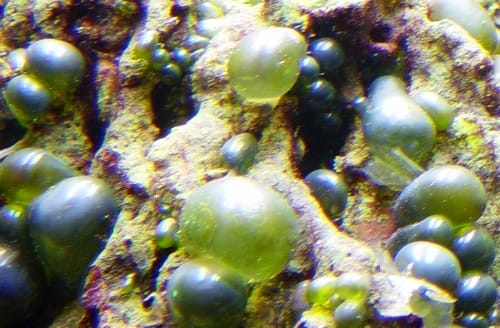For most, Bubble Algae is the plague of all algae. This green, bubble shaped algae grows rapidly and thrives even in low nutrient settings. It is also difficult to remove and control in the home aquarium. Green Bubble Algae typically grows in the deep crevices and holes of live rock. It can appear without warning in new and well established aquariums and comes in many varieties, but the most famous is the family Valonia.
Prevent Bubble Algae
1. Use Reverse Osmosis water to prevent the introduction of phosphates and nitrates. Typical tap and well water has a TDS, Total Dissolved Solids, of 250 to 500ppm. TDS is how much stuff is in your water. This includes copper, chlorine, phosphate, silicate, iron, zinc, lead and nitrate. After Reverse Osmosis purification the typical TDS is between 5 and 10ppm and after RO Deionization purification it is between 0 and 5ppm. As a result, algae has 25 to 50 times less nutrients that it can use to grow.
2. Reduce the frequency of feedings and the amount of food fed to the aquarium. Stop feeding flake and pellet food. Instead, use high quality frozen or live foods as they typically contain less phosphate and nitrate.
3. Examine all live rock and coral fragments for signs of bubble algae before introducing them into your aquarium. Manually remove any bubbles or consider breaking of the infected piece of rock.
4. Use a GFO, Granular Ferric Oxide, like Phosban to remove phosphate from the water.
How to Treat Bubble Algae
1. Manual Removal is the easiest and fastest way to reduce the population of Green Bubble Algae in the aquarium. Start by removing the infected piece of live rock from the aquarium. Using your fingers or a tweezers, gently remove as many bubbles as you can from the rock without popping the bubbles. Next, siphon out a few gallons of aquarium water into a clean container. Begin removing the difficult bubbles by all means necessary, even if this means popping the bubbles. After you are finished, shake the live rock in the bucket of saltwater to minimize the number of spores reentering your aquarium. Then reintroduce the piece of live rock into the aquarium. There is a debate about whether popping the bubbles is a good idea or bad idea. If you pop the bubbles, you risk spreading the algae, but if the bubbles are allowed to reach a mature size, they will eventually grow and naturally release more spores into the water column.
2. Some of the most active Bubble Algae eaters are Emerald Mythrax Crabs. These crabs use their claws to pluck out and eat the bubble algae. About one crab per 25 gallons of water is recommended.
3. Some fish, like the Desjardini Sailfin Tang have been reported to eat Bubble Algae, but they require an aquarium 75 gallons or larger.

4. Add a Refugium and macroalgae to compete with the Green Bubble Algae for nutrients. Popular macroalgaes are Caulerpa and Chaetomorpha.
5. If the problem persists for many months, a full live rock treatment may be necessary. The first method consists of placing all of your live rock in the dark for several months to eliminate all of the bubble algae. You will need to filter the water and perform routine water changes. The second method consists of a one part muriatic acid to 100 part fresh water dip. This will essentially kill anything living on your live rock and will leave you with dead base rock, which will need to be rinsed and seeded with fresh live rock to repopulate the living organisms. Warning, muriatic acid is extremely dangerous and should be handled with care. Please read the products warning label for safety instructions.
The best way to attack an infected aquarium is to manually remove any Bubble Algae and then use natural predators, like emerald crabs to reduce and finally eliminate the population. Without persistence, Bubble Algae will grow out of control and a full tank treatment will be required.
